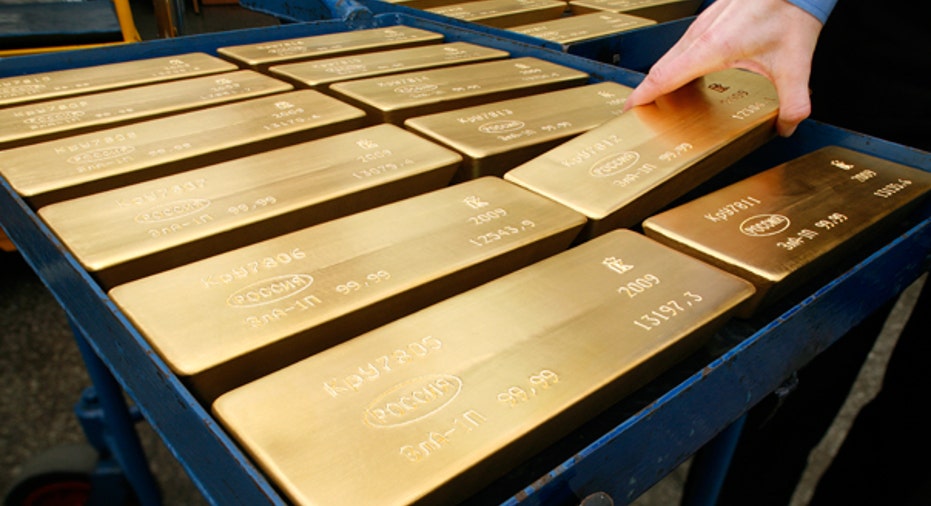Gold Halts Four-Day Slide on Easing Hopes

Gold prices rose on Tuesday, snapping four days of losses, as expectations that central banks would opt to maintain ultra-loose monetary policy this week helped push European stocks to a two-year high and weighed on the dollar.
Successive rounds of quantitative easing and similar monetary stimulus measures have kept liquidity high and interest rates low in the United States, the euro zone and Japan in recent years, fuelling a rally in gold prices.
Hopes that stimulus would continue were boosted by comments from Federal Reserve official Janet Yellen on Monday, as well as expectations new economic forecasts in the euro zone could open the way to looser policy from the European Central Bank (ECB).
"The Fed and its monetary policy actions are still the biggest issue day-to-day in the gold market, but you can see more discussion also about the possibility of looser monetary policy in Japan, or within Europe, or elsewhere," Mitsui Precious Metals analyst David Jollie said.
"There's more of a realisation that economic growth is not yet at a level that any country is happy with, and that therefore we could see further easing."
Spot gold was up 0.5 percent at $1,581.84 an ounce at 1104 GMT, while U.S. gold futures for April delivery were up $9.50 an ounce at $1,581.90.
ECB policymakers meet in Frankfurt on Thursday as political deadlock in Italy fuels fears the euro zone crisis could reignite. The bank is likely to hold off quick-fire action, but could hint at looser policy in future.
The Bank of Japan and the Bank of England are also set to hold two-day monetary policy meetings from Wednesday.
"Behind (Fed chief Ben) Bernanke's dovish appearance last week, from the January minutes and from the end of last year, we know the hawks are getting louder, saying we need at least a contingency to pull out of (QE)," VTB Capital analyst Andrey Kryuchenkov said.
"In Europe, we don't even have that. (ECB President Mario) Draghi maintains a dovish stance even without lowering the rate."
SPDR SEES FRESH OUTFLOW
Appetite for gold-backed exchange-traded funds remained soft, with the largest, New York's SPDR Gold Shares, reporting a ninth straight daily outflow of metal on Monday, this time of 0.6 tonnes.
The fund reported its largest ever monthly outflow last in February and has seen holdings fall by 97.5 tonnes since the start of the year, compared to a 39-tonne rise in the same period of 2012.
Buying in key Asian physical markets has also been hurt by recent price volatility, dealers said.
"We are not seeing as much buying as last week," Brian Lan, managing director at GoldSilver Central in Singapore, said. "Most people... are now holding back, wondering whether prices will fall further, before they commit themselves to buy more."
Bank of America-Merrill Lynch cut its gold price forecasts on Tuesday, saying it now sees gold at $1,680 an ounce this year, against a previous forecast of $1,805, and at $1,838 in 2014, against $2,038. It slashed its 2015 forecast by more than 10 percent to $1,675 an ounce, from $1,900.
Among other precious metals, silver was up 1.2 percent at $28.87 an ounce. Spot platinum was up 1 percent at $1,580.24 an ounce, while spot palladium was up 1 percent at $721.90 an ounce.
Platinum prices rose sharply after news of fresh labour unrest at the world's number three platinum miner Lonmin , which said on Tuesday around 6,000 workers at its Marikana mine had gone on an illegal strike.
However, it swiftly retraced as news broke that the strike had been resolved.
South African police opened fire on striking miners at the Marikana mine last August, killing 34 workers in scenes that evoked comparisons with apartheid-era brutality.
The wave of labour unrest that followed curbed platinum output from South Africa, the source of around three-quarters of supply of the white metal, last year, helping prices overcome a slump in demand from automakers. (Additional reporting by Natalie Huet in London, Rujun Shen in Singapore; editing by James Jukwey)



















